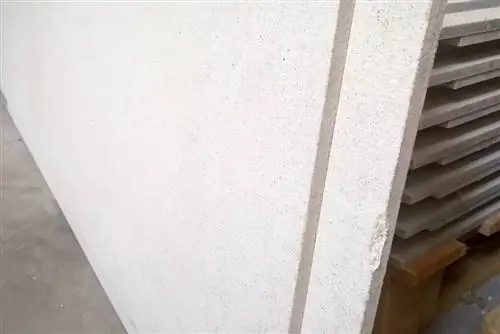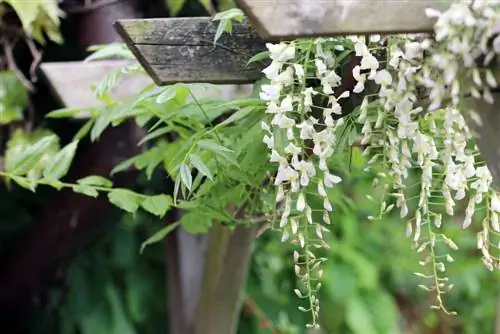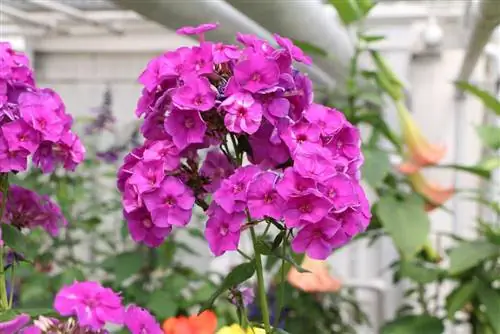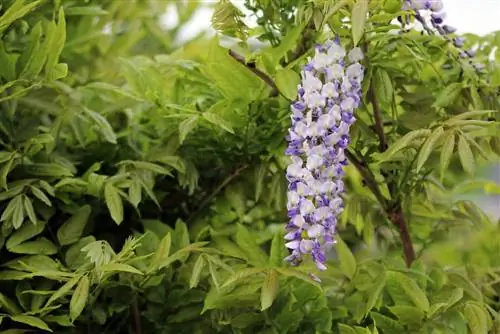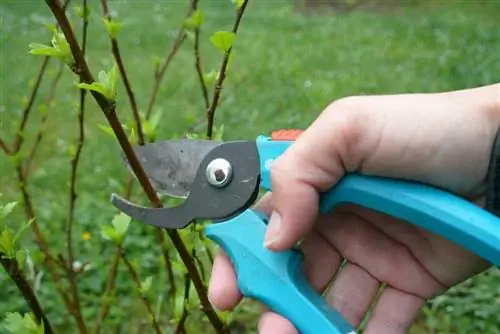- Author admin [email protected].
- Public 2023-12-17 03:39.
- Last modified 2025-06-01 06:48.
Wisteria is also called wisteria and is a butterfly flower. All wisteria species are very robust, strong-growing climbing plants with very showy, large flower clusters. They can reach heights of up to 30 m. Wisteria originally comes from East Asia and North America. The plant usually flowers twice a year. The flowers in spring appear before the leaves. The second flowering follows in July/August.
Wisteria is perennial. In winter only the young wood freezes back a little.
Wisteria is poisonous, all parts of the plant, but especially the seeds, pods, bark and roots.
Wisteria (wisteria) comes in blue, white and pink. The first flowers appear after about five years.
The plant does not need much care, but it does need to be pruned regularly. A flower only appears when the buds are stimulated to bloom by pruning. Strongly growing, sprawling shoots should be cut back to cones, i.e. above a strong bud. The many two to three year old thin shoots can be removed. Larger, sprawling branches should be rejuvenated with a saw if necessary. Strong shoots must be removed from rain gutters as they can compress gutters. Otherwise, you should not let the wisteria dry out, especially not in the spring before flowering. In dry conditions the buds may fall off. But waterlogging is also not tolerated. The soil must be rich in humus. Unless there is a risk of voles, you should mulch. If the wisteria is not blooming properly, it should be fertilized.
Wisteria (wisteria) can be propagated by cuttings or planters. Growing from seeds is not recommended. It is better to refine plants (goat's foot grafting, root grafting). They bloom earlier than those grown from seeds.
The wisteria requires a stable, preferably rod-like trellis that is tailored to the height and width of the plant. Trellises should be 2 meters away from lightning rods, downpipes, gutters and eaves.
Stimulating wisteria to bloom
The wisteria, wisteria, wisteria, as the wisteria is also called, belongs to the subfamily of the butterflies (Faboideae) and to the legume family (Fabaceae). The climbing plant is poisonous.
It is a vigorous plant and requires climbing aid. In order for it to produce its grape-shaped flowers, which can be up to 30 centimeters long, not only good care is required, but other conditions can also force early flowering.
It is interesting to compare different specimens of this climbing plant. Because while some of them live up to their name and “rain down” numerous blue flower clusters, other wisterias don’t have a single flower on them - and have done so for several years.
You also have this problem and your wisteria isn't blooming? That's why you want to encourage it to bloom. Find out more about how you can encourage your wisteria to bloom here.
Propagation from seeds unfavorable
Wisteria grown from seeds rarely blooms. Therefore, this type of propagation is not to be favored. When buying a Wisteria, you should pay attention to grafted plants. There are also differences in the type of plant. In addition to the Chinese wisteria (Wistria sinensis), there is also the Japanese wisteria (Wistria floribunda) and several other species.
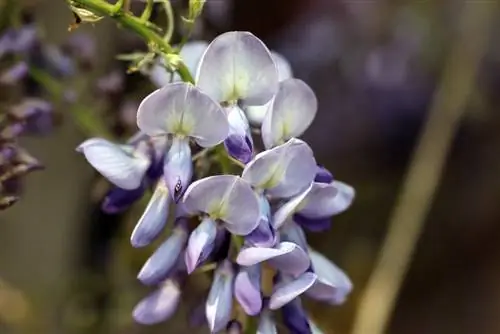
In addition to the eponymous blue-violet flower color, some varieties also produce flowers in white and pinkish red. The Japanese wisteria is weaker in growth and only grows to around five meters high. However, this might even be desirable in some gardens or on facades. However, this species should only bloom for the first time after about ten years. However, various varieties, such as the Wisteria formosa Issai Perfect, are said to bloom for the first time after just three years. Depending on the variety, it may even be possible to bloom again in late summer / early autumn.
Dare to prune boldly
Wisteria's ability to bloom can be encouraged by careful pruning. Don't be afraid to cut back your wisteria rigorously with sharp pruning shears. Pruning the Wisteria is similar to pruning a grapevine:
- Up to a length of about ten centimeters - about three eyes should remain - all side shoots that are not intended to serve as the main framework are shortened. This measure is necessary so that short shoots can form that bloom profusely.
- This cut should be carried out in late summer. In the following years, the new shoots should be protected.
The wisteria can be expected to bloom after about two to three years. There is little you can do with pruning against the plant's own conditions, such as propagation through a seedling, as far as species or varieties with late flowering are concerned. There is only one remedy here, and that is to practice patience. Read more tips for cutting wisteria here.
Cutting measures
When it comes to pruning on wisteria, a distinction is made between planting pruning and pruning. There are also various reasons why the Wisteria should be cut back. One of these is to encourage the climbing plant to bloom. Another reason why pruning of the climbing plant is essential is to prevent damage to the climbing aids.
The plant cut
Immediately after planting, the strong-growing climbing plants must be cut back to just a few eyes. This planting cut is the prerequisite for the wisteria to bloom after just two to three years. If pruning is not carried out, the gycinia may not produce its first flowers for several years. The moist, humus-rich soil should be lightly piled up after planting so that the eyes sprout more easily.
The pruning
When pruning, it is important to ensure that it is done correctly. If you prune incorrectly, flower-producing shoots could possibly be unknowingly removed. Wisteria blooms on perennial wood. Therefore, you should not carry out any cosmetic measures when pruning young or annual shoots. Instead, if necessary, the leading shoots are thinned out into the perennial wood.
The wisteria can be rejuvenated by cutting it back to around 40 to 50 centimeters. When pruning Wisteria, the procedure is similar to that of grape vines:
- This means that all side shoots that do not serve as the main framework are shortened drastically (except for about three eyes).
- So that short shoots are formed that bloom profusely, this cut should be carried out in late summer (August).
- In the summer itself, it can be cut back as needed. However, you should only carefully remove the new growth because birds often nest in the branches. The feathered garden friends should not be disturbed while they are breeding.
Short profile
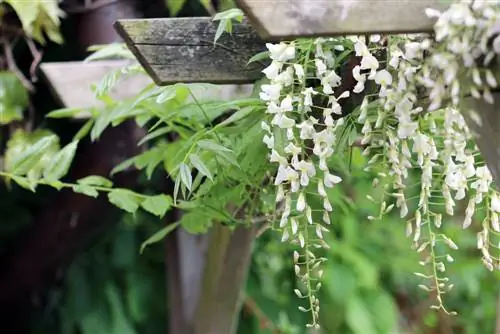
The poisonous plant owes its name to the blue butterfly flowers, which hang from the shoots in clusters about 30 centimeters long. Wisteria produces the strongly fragrant, eye-catching blue-purple flower clusters from April to June. The two main species are Chinese wisteria (Wistria sinensis) and Japanese wisteria (Wistria floribunda).
In addition to the blue flowers that give them their name, they can also have white or pink flowers. The leaves of glycinia are imparipinnate. They consist of around seven to eleven elliptically shaped leaflets. The brown, hairy pods, which are approximately ten to twelve centimeters long, contain many seeds.


